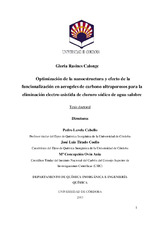Mostrar el registro sencillo del ítem
Optimización de la nanoestructura y efecto de la funcionalización en aerogeles de carbono ultraporosos para la eliminación electro-asistida de cloruro sódico de agua salobre
| dc.contributor.advisor | Lavela Cabello, Pedro | |
| dc.contributor.advisor | Tirado Coello, José Luis | |
| dc.contributor.advisor | Ovin Ania, Mª Concepción | |
| dc.contributor.author | Rasines, G. | |
| dc.date.accessioned | 2015-07-30T08:08:21Z | |
| dc.date.available | 2015-07-30T08:08:21Z | |
| dc.date.issued | 2015 | |
| dc.identifier.uri | http://hdl.handle.net/10396/12887 | |
| dc.description.abstract | Los resultados descritos en esta memoria de Tesis Doctoral han pretendido demostrar que la optimización de los parámetros de síntesis, el dopado con nitrógeno y la formación de nanocompuestos son herramientas adecuadas para controlar las propiedades estructurales y morfológicas de aerogeles de carbono. Los monolitos nanoestructurados de elevada porosidad que se prepararon, mostraron ser buenos candidatos para su potencial aplicación en eliminación electro-asistida de sales en aguas salinas. Con el objeto de proceder a una exposición resumida y ordenada de los resultados más destacables, se ha procedido a diferenciarlos según los siguientes capítulos: 1. Respuesta electroquímica de electrodos de aerogeles de carbono en agua salina. 2. Efecto de la activación con CO2 en la micro y mesoporosidad de aerogeles de carbono. 3. Composites mesoporosos de aerogel y negro de carbono con propiedades optimizadas para la eliminación electro-asistida de cloruro de sodio de agua salobre. 4. Electrodos de aerogel de carbono monolíticos dopados con nitrógeno con características optimizadas para la electroadsorción de iones. 5. Empleo de aerogeles de carbono dopados con nitrógeno y cargados con negro de carbono para la electrosorción de cloruro sódico de agua salina. 1. Respuesta electroquímica de electrodos de aerogeles de carbono en agua salina. Se sintetizaron varios aerogeles de carbono con proporciones resorcinolcatalizador (R/C) que oscilaron entre 25 y 200. Para el valor más bajo de R/C, la isoterma de adsorción de nitrógeno mostró un perfil de tipo I, indicando el predominio de la microporosidad. El incremento de R/C indujo un cambio de los perfiles hacia el tipo IV característico de una estructura mesoporosa más desarrollada. La presencia de... | es_ES |
| dc.description.abstract | 1. Electrochemical response of carbon aerogel electrodes in saline water. Four carbon aerogels were obtained by the sol–gel polymerization with resorcinol/catalyst (R/C) ratios between 25 and 200. As the R/C was increased, the carbon aerogels displayed a much more developed mesoporous structure showing type IV nitrogen adsorption isotherms. The sample prepared with R/C of 200 displayed a characteristic H1 desorption loop, where the adsorption and desorption branches are rather vertical and almost parallel over the gas uptake, which indicates a rather narrow distribution of pore sizes within the mesopore range. It would be expected that high R/C ratios give rise to large pore volumes due to the formation of clusters of large sizes with a highly cross-linked structure. Data also showed that the sharp increase in the surface area at low R/C values is gradually lowered until it reaches an almost limiting value at high R/C ratio. This suggests that the polycondensation of the reactants under low amounts of catalyst favors the formation of mesopores rather than micropores. Cyclic voltammograms recorded in a 10 g L-1 NaCl electrolyte solution, and at the lowest scan rates, showed a nearly rectangular-shaped profiles ascribable to the pure capacitive behavior when ions are effectively electro-adsorbed/desorbed within the electric double layer at the electrode surface. As a general trend, those carbon aerogels exhibiting a well developed microporosity interconnected by an adequate mesoporous network showed large capacitance values and faster electro-adsorption kinetics. Thus, a capacitance value as high as 76 F g-1 was recorded for the sample prepared with R/C of 200 at 1 mV s-1 rate. This value is higher than that reported in the literature for related carbon aerogels. On increasing the scan rate, the shape of the voltammogram was flattened and the capacitance values drastically decreased for all the materials, the effect being particularly remarkable for the sample with R/C of AG25 which displayed the lowest mesopore volume. Indeed, the diffusion of the ionic species in solution controls the performance of the electrodes at high current loadings. At low scan rates, no restrictions in the ion mobility are expected, thus the capacitance values should be mainly correlated with the textural features of the electrodes. On the other hand at high... | es_ES |
| dc.format.mimetype | application/pdf | es_ES |
| dc.language.iso | spa | es_ES |
| dc.publisher | Universidad de Córdoba, UCOPress | es_ES |
| dc.rights | https://creativecommons.org/licenses/by-nc-nd/4.0/ | es_ES |
| dc.subject | Nanoestructuras | es_ES |
| dc.subject | Electrodos de aerogeles de carbono | es_ES |
| dc.subject | Aguas salinas | es_ES |
| dc.subject | Espectroscopía | es_ES |
| dc.title | Optimización de la nanoestructura y efecto de la funcionalización en aerogeles de carbono ultraporosos para la eliminación electro-asistida de cloruro sódico de agua salobre | es_ES |
| dc.type | info:eu-repo/semantics/doctoralThesis | es_ES |
| dc.rights.accessRights | info:eu-repo/semantics/openAccess | es_ES |

